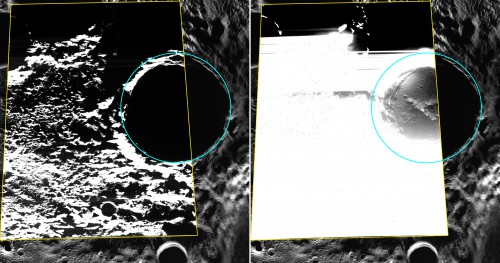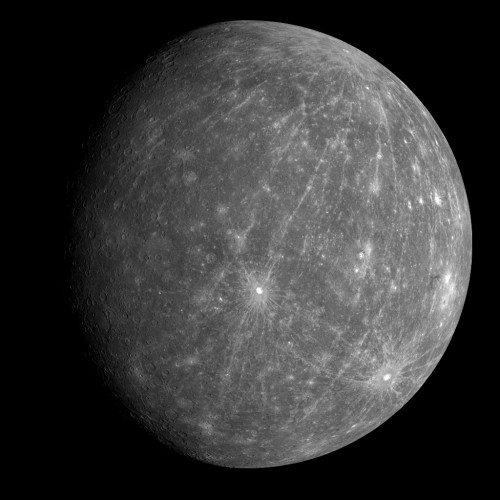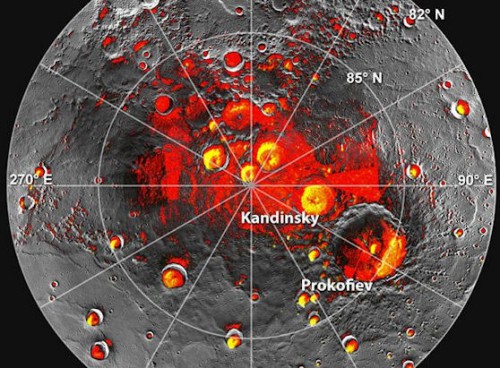
The Solar System is full of surprises. Mercury, the planet closest to the Sun, is a baking hot world, as would be expected. It is one of the last places where you would think anything would or could be frozen, but things aren’t always as they seem. There has been tantalizing evidence already for water ice deposits in craters at Mercury’s north pole, and now the MESSENGER spacecraft in orbit around the small planet has visually confirmed it for the first time.
Ice? On Mercury? How is that even possible? The answer is relatively simple: The craters near the north pole are in permanent shadow, and with no atmosphere to distribute heat, the surface in shadowed and nighttime areas will plunge to very cold temperatures even though the surface still in sunlight is extremely hot. Temperatures just below the surface can also be cold enough for ice to form.

Much of the ice was seen in Prokofiev crater, and these patches look bright in radar images. As Nancy Chabot, the Instrument Scientist for MESSENGER’s Mercury Dual Imaging System (MDIS) and a planetary scientist at the Johns Hopkins University Applied Physics Laboratory in Laurel, Md., explained: “Those images show extensive regions with distinctive reflectance properties. A location interpreted as hosting widespread surface water ice exhibits a cratered texture indicating that the ice was emplaced more recently than any of the underlying craters.”
In other areas, the ice appears to be covered by a thin layer of dark, organic-rich material. Those dark deposits tend to have distinctly sharp boundaries, which is considered unusual. As Chabot noted, “This result was a little surprising, because sharp boundaries indicate that the volatile deposits at Mercury’s poles are geologically young, relative to the time scale for lateral mixing by impacts.”
The new images were taken with MESSENGER’s Wide-Angle Camera (WAC). By leveraging the very low levels of light being scattered by illuminated crater walls, the WAC was able to image the ice deposits even though they are always in shadow. “It worked in spectacular fashion,” said Chabot.
The images provide evidence that the ice was either delivered to Mercury recently, such as by comets, or are regularly restored on the surface by some kind of on-going process. As Chabot asked: “One of the big questions we’ve been grappling with is ‘When did Mercury’s water ice deposits show up?’ Are they billions of years old, or were they emplaced only recently? Understanding the age of these deposits has implications for understanding the delivery of water to all the terrestrial planets, including Earth.”

They also indicate differences between ice deposits on Mercury and the Moon. There is evidence for ice in craters in permanently shadowed craters on the Moon also, but they look different from the Mercurial ones, according to Chabot. She postulates: “One explanation for differences between the Moon and Mercury could be that the volatile polar deposits on Mercury were recently emplaced. If Mercury’s currently substantial polar volatile inventory is the product of the most recent portion of a longer process, then a considerable mass of volatiles may have been delivered to the inner Solar System throughout its history.”
As to why there are those differences between Mercury and the Moon, which generally look a lot alike, Chabot notes: “That’s a key question. Because if you can understand why one body looks one way and another looks different, you gain insight into the process that’s behind it, which in turn is tied to the age and distribution of water ice in the Solar System. This will be a very interesting line of inquiry going forward.”
It was a surprise to previously find ice on the Moon, and even more so on Mercury. Just the fact that water ice can even exist on planets like Mercury is a fascinating discovery in itself; as the saying goes, sometimes we should expect the unexpected.
The new findings were published on Oct. 15 in the journal Geology.
Want to keep up-to-date with all things space? Be sure to “Like” AmericaSpace on Facebook and follow us on Twitter: @AmericaSpace




“In other areas, the ice appears to be covered by a thin layer of dark, organic-rich material. Those dark deposits tend to have distinctly sharp boundaries, which is considered unusual. ”
Organic matter?! On Mercury? Water ice, possibly continuously renewing from below? And all that solar energy… Is it possible, microbial life????
Organic matter in this case is just simple organics, probably deposited by comets or asteroids. Not likely any connection to life itself. But if there were somehow pockets of liquid water below the surface though in places between being too hot and too cold, that would be interesting! I’m sure all these deposits will be studied further; a lander would be nice…
As is the case for exploration of the Jupiter/Saturn moons, a lander on Mercury would provide scientists with invaluable data on the search for water/ice deposits. It’s a relatively “short hop” to the planet. Let’s do it!
Quite expensive short hop. With no atmosphere on Mercury, if you want land safely there’ you have to do it by thrust. Which means lot of fuel, which means heavier spacecraft, which needs bigger rocket…